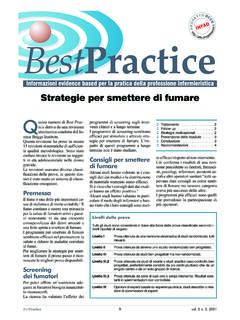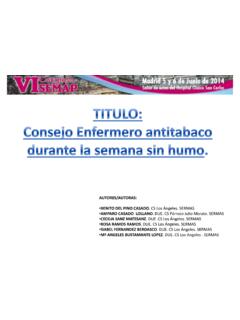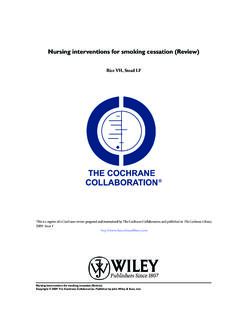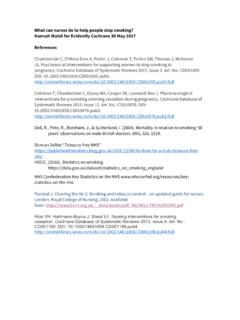Transcription of The complexity of COPD and medication adherence - GALA
1 In PracticePeer reviewedThe complexity of copd and medication adherence Key learning points:u Patients with copd may also suffer from other conditions, such as anxiety disorders, cardiac disease or diabetesu Tobacco smoking is recognised as the most common cause of copd , so smoking cessation may be one way of successfully managing the conditionu Between 20% and 50% of copd patients are non-adherent, the main problem being misunderstanding medicationChronic obstructive pulmonary disease ( copd ) is recognised as one of the most common respiratory diseases in the UK, with over 5 million people ,2 Maintaining 'quality of life' is dependent on a range of care, including prescribed medication . However, studies from the 1990s and more recent research identify that those diagnosed with copd often struggle to manage their medication due to a range of health-related co-morbidities can comprise a range of conditions such as anxiety disorders or those of organ function, for example cardiac disease or diabetes.
2 However, the manage-ment of the co-morbidity can also affect the person s copd and vice versa. These further complexities add to the overall pharmacologi-cal burden. Moreover, there is little guidance for the health professional on the most appropri-ate choice of medication adherence medication compliance and adherence is a major component in copd The nurse is key in screening and monitoring these patients and the role is recognised as increasingly important in supporting the role of the physician and providing continuity of care4,5 in particular health promotion and patient The community nurse is often able to view at fi rst hand some of the copd patient s daily challenges, which may shed light on reasons for non-compliance. It is recognised that suboptimal medication levels impact adversely on the patient and also generally on healthcare expenditure. Braido et al7 identifi ed compliancy as something that involves a defi nite decision on the part of the person to accept their condition and their management.
3 However, the issues surrounding copd as a whole can be complex. In the arena of poor compliance, a whole raft of other elements may be identifi ed, such as personal limitations caused by the disease ageing processes, poor cognition abilities, anxiety states and Other factors may include a reduced belief in the effi cacy of the medication , underestimation of the severity of the condition and tobacco Tobacco smoking is recognised as the commonest cause of copd . The evidence for nurse-led smoking cessation pro-grammes has shown positive However, for many people smoking is part of their social construct; an activity that provides pleasure, relaxation and helps relieve Therefore, successfully managing copd may include a person making multiple lifestyle changes such as smoking cessation and starting an exercise regime as well as medication adherence but this may be hard to achieve in medication MIsMANAGeMeNT Studies from the late 1990s demonstrated that up to 90% of patients with inhaled medications were not using their inhaler devices ,14 Dry powder inhalers (DPIs) and pressurised metered dose inhalers (pMDIs) are the most commonly used delivery systems for dispensing aerosol drugs and are recommended at all stages of treatment.
4 Worldwide they are the most frequently prescribed recent research identify that those diagnosed with copd often struggle to manage their medication due to a for the health professional on the most appropri-states and belief in the effi cacy of the medication , underestimation of the severity of the condition and tobacco cause of copd . The evidence for nurse-led smoking cessation pro-grammes has shown positive , for many people smoking is part of their social construct; an activity that provides pleasure, relaxation and helps relieve , successfully managing copd may include a person making multiple lifestyle changes such as smoking cessation and starting an exercise regime as well as medication adherence but this may be rona DurySenior lecturer, Department of Adult Nursing and Paramedic Science, University of GreenwichCLINICAL: respIrAtoryP69_70_73_CLINICAL_COPD_NIP94 6916/01/2017 13:2870 Nursing in , and are considered the cornerstone of copd These plus adjunctive therapies such as smoking cessation and oxygen and drug therapy have long been recognised as mainstays of copd ,17 However, the management of copd is multifaceted, due to the long-term and changing nature of the disease, which can also include periods of remission.
5 Also, copd is often associated with multiple comorbidities, which may require other medications, administered by varying routes. Furthermore, differing disease combinations can prompt changes to medication regimes which can influence an individual s copd is a long-term condition and a study by the WHO in 2003 estimated that there is a 50% adherence or less for patients taking medications over a long period, with the improper use of medication being more frequent in those over 65, especially when coupled with Prescribing appropriately and accommodating some of the problems faced by patients requires a holistic assess-ment to identify potential problems that may affect However, there is little advice on inhaler selection in prescribing guidelines. Therefore the primary focus could be on medication choice, not the patient s ability to use the Between 20% and 50% of patients with copd are considered to be non-adherent.
6 The main problem is medication being ,23 There is also the problem of polypharmacy and improper use of medication delivery, which increases in patients over 65. Problems include a lack of understanding of how the medication device functions, incorrect inhaler technique and difficulties in handling the inhaler, which may be attributable to poor co-ordination between inspiration and inhaler A combination of these elements is considered to be particularly common in the older age group or those with advanced lung damage. The inhalation force is another major aspect in compliance. Manufacturers recommend a deep and hard inhalation, which allows a fast acceleration rate and allows the formulation of the metered dose to break into particles that enter the inspired airstream and deposit in the However, the level of resistance in the inhaler device, coupled with the level of copd obstruction can affect the rate of flow. Therefore, patients with severe copd are not always able to achieve fast inhalation Incorrect use of pMDIs, especially in those not using a spacer, and failure to co-ordinate inspiration with actuation results in a reduced deposition in the lung.
7 A significant correlation has been identified between a patient s satisfaction with their device and their level of compliance. A poor inhaler technique has been linked to increased use of reliever medication and also to a rise in the use of emergency services, which demonstrates the importance of patient support and good 7, 2 8 A change in device can also be a cause of poor compliance. With this in mind, the European Respiratory Society has recom-mended that patients remain on their current inhaler regime if their disease is Nurse s roleThe primary care nurse has an important role in supporting the patient at all stages from initial diagnosis to end-of-life care. The community nurse is often able to view at first hand some of the challenges that a copd patient may experience on a daily basis 90% of patients with inhaled medications are not using their inhaler devices correctly CLINICAL: respIrAtoryP69_70_73_CLINICAL_COPD_NIP94 7016/01/2017 13 in PracticeHowever, although the literature contains information on the reactive aspects of copd care, there is little about proactive management.
8 It has been noted that health professionals may fail to recognise non- adherence and might instead attribute symptom changes to other This is not surprising, as copd can be highly complex and encompass periods of exacerbation and remission. In many cases, the symptoms might include mental health problems such as depression. The literature supports the view that strong education initiatives enable patients to manage their medication more effectively. However, due to the changing nature of copd , it could be considered that some medication regimes can be just as complex as the condition itself. In 2008, the Department of Health made a case in its paper the NHS Next Stage Review for high-quality community care that encourages patient empowerment and self-management. Likewise NICE guidelines (2010) and the Five-Year Forward View (2014)30 identified the role of the multi-disciplinary team in copd ,32 The team includes the primary care nurse, whose assessment and care coordination skills have been described as invaluable in providing advice, education and support to prevent inappropriate hospital admissions.
9 This supports the view that the primary care nurse is well placed to identify and respond, to enable a patient to do better in a condition that is progressive and ,34,35 refereNces1. Department of Health. Outcomes strategy for Chronic Obstructive Pulmonary Disease in England. Crown Copyright Halbert RJ, Natoli JL, Gano A et al. Global burden of copd : systematic review and meta analysis. Eur Respir 2006;28 Global Initiative for Chronic Obstructive Lung Disease (2011). Global Strategy for the diagnosis, management and prevention of chronic obstructive pulmonary disease. Fletcher M, Dahl B. Expanding nursing practice in copd : is it key to providing high-quality, effective, and safe patient care? Primary Care Respir J 2013;22 Palmer, A. Registered Nurse's Role in copd care. The Journal of Nursing, 2013. Barry MJ. Chronic obstructive pulmonary disease: developing comprehensive management. Respir Care 2003;48:1225-34.
10 7. Braido F, Balardino I, Sumberesi M et al. Obstructive lung diseases and inhaler treatment: results from a national public pragmatic Res 2013; WilhelmK, Arnold K, Niven H et al. Grey Lungs and blue moods: smoking cessation in the context of lifetime depression history. Aust NZJ Psychiatry 2004;38 Ostrowski M. Report takes aim at America s other drug problem: poor adherence . J Fam Pract 20 07;577:73 4. 10. rice VH, stead lf . (2008) Nursing Interventions for smoking cessation (Review) Cochrane database of Systematic Reviews. Issue 1 : 001188 pub Kant S, Gupta B. Role of Lifestyle in the Development of Chronic Obstructive Pulmonary Disease; A Review. Lung India Apri-Jun; 25:9 5 -10112. Pauwels RA, Buist AS, Calverley PM et al. Global strategy for the diagnosis, management and prevention of chronic obstructive pulmonary disease. NHLB/WHO Global Initiative for Chronic Obstructive Pulmonary Lung Disease (GOLD) Workshop summary Am J Respir Crit Care Med 2001;163 Plaza V, Sanchis J.










